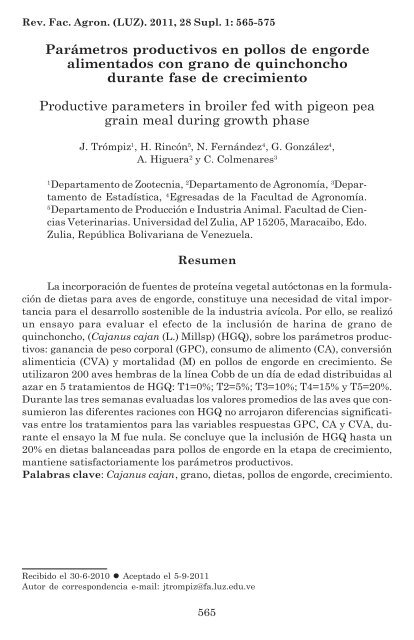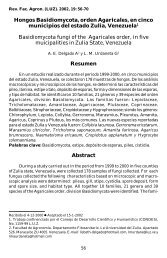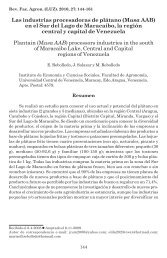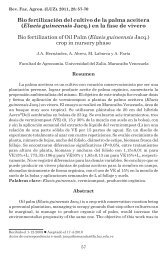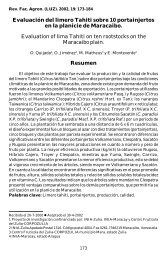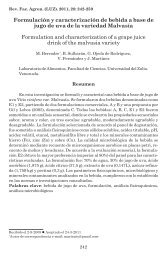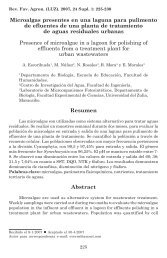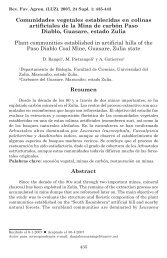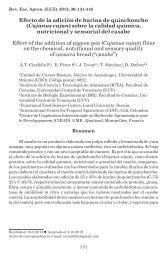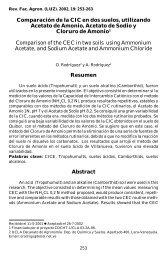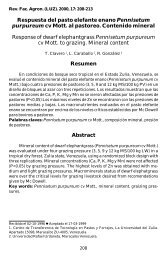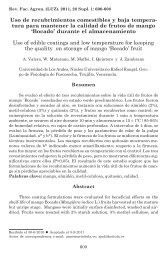Parámetros productivos en pollos de engorde alimentados con ...
Parámetros productivos en pollos de engorde alimentados con ...
Parámetros productivos en pollos de engorde alimentados con ...
You also want an ePaper? Increase the reach of your titles
YUMPU automatically turns print PDFs into web optimized ePapers that Google loves.
Rev. Fac. Agron. (LUZ). 2011, 28 Supl. 1: 565-575<br />
<strong>Parámetros</strong> <strong>productivos</strong> <strong>en</strong> <strong>pollos</strong> <strong>de</strong> <strong>en</strong>gor<strong>de</strong><br />
alim<strong>en</strong>tados <strong>con</strong> grano <strong>de</strong> quinchoncho<br />
durante fase <strong>de</strong> crecimi<strong>en</strong>to<br />
Productive parameters in broiler fed with pigeon pea<br />
grain meal during growth phase<br />
J. Trómpiz 1 , H. Rincón 5 , N. Fernán<strong>de</strong>z 4 , G. González 4 ,<br />
A. Higuera 2 y C. Colm<strong>en</strong>ares 3<br />
1 Departam<strong>en</strong>to <strong>de</strong> Zootecnia, 2 Departam<strong>en</strong>to <strong>de</strong> Agronomía, 3 Departam<strong>en</strong>to<br />
<strong>de</strong> Estadística, 4 Egresadas <strong>de</strong> la Facultad <strong>de</strong> Agronomía.<br />
5 Departam<strong>en</strong>to <strong>de</strong> Producción e Industria Animal. Facultad <strong>de</strong> Ci<strong>en</strong>cias<br />
Veterinarias. Universidad <strong>de</strong>l Zulia, AP 15205, Maracaibo, Edo.<br />
Zulia, República Bolivariana <strong>de</strong> V<strong>en</strong>ezuela.<br />
Resum<strong>en</strong><br />
La incorporación <strong>de</strong> fu<strong>en</strong>tes <strong>de</strong> proteína vegetal autóctonas <strong>en</strong> la formulación<br />
<strong>de</strong> dietas para aves <strong>de</strong> <strong>en</strong>gor<strong>de</strong>, <strong>con</strong>stituye una necesidad <strong>de</strong> vital importancia<br />
para el <strong>de</strong>sarrollo sost<strong>en</strong>ible <strong>de</strong> la industria avícola. Por ello, se realizó<br />
un <strong>en</strong>sayo para evaluar el efecto <strong>de</strong> la inclusión <strong>de</strong> harina <strong>de</strong> grano <strong>de</strong><br />
quinchoncho, (Cajanus cajan (L.) Millsp) (HGQ), sobre los parámetros <strong>productivos</strong>:<br />
ganancia <strong>de</strong> peso corporal (GPC), <strong>con</strong>sumo <strong>de</strong> alim<strong>en</strong>to (CA), <strong>con</strong>versión<br />
alim<strong>en</strong>ticia (CVA) y mortalidad (M) <strong>en</strong> <strong>pollos</strong> <strong>de</strong> <strong>en</strong>gor<strong>de</strong> <strong>en</strong> crecimi<strong>en</strong>to. Se<br />
utilizaron 200 aves hembras <strong>de</strong> la línea Cobb <strong>de</strong> un día <strong>de</strong> edad distribuidas al<br />
azar <strong>en</strong> 5 tratami<strong>en</strong>tos <strong>de</strong> HGQ: T1=0%; T2=5%; T3=10%; T4=15% y T5=20%.<br />
Durante las tres semanas evaluadas los valores promedios <strong>de</strong> las aves que <strong>con</strong>sumieron<br />
las difer<strong>en</strong>tes raciones <strong>con</strong> HGQ no arrojaron difer<strong>en</strong>cias significativas<br />
<strong>en</strong>tre los tratami<strong>en</strong>tos para las variables respuestas GPC, CA y CVA, durante<br />
el <strong>en</strong>sayo la M fue nula. Se <strong>con</strong>cluye que la inclusión <strong>de</strong> HGQ hasta un<br />
20% <strong>en</strong> dietas balanceadas para <strong>pollos</strong> <strong>de</strong> <strong>en</strong>gor<strong>de</strong> <strong>en</strong> la etapa <strong>de</strong> crecimi<strong>en</strong>to,<br />
manti<strong>en</strong>e satisfactoriam<strong>en</strong>te los parámetros <strong>productivos</strong>.<br />
Palabras clave: Cajanus cajan, grano, dietas, <strong>pollos</strong> <strong>de</strong> <strong>en</strong>gor<strong>de</strong>, crecimi<strong>en</strong>to.<br />
Recibido el 30-6-2010 Aceptado el 5-9-2011<br />
Autor <strong>de</strong> correspond<strong>en</strong>cia e-mail: jtrompiz@fa.luz.edu.ve<br />
565
Trómpiz et al.<br />
Abstract<br />
The incorporation of autochthonous sources of vegetable protein in the<br />
formulation of diets for broilers <strong>con</strong>stitutes a need of vital importance for the<br />
sustainable <strong>de</strong>velopm<strong>en</strong>t of poultry industry. A test was carried out to evaluate<br />
the effect of the incorporation of pigeon pea grain meal, (Cajanus cajan (L.)<br />
Millsp) (PGM), on the productive parameters: weight gain (BWG), feed intake<br />
(FI), feed <strong>con</strong>version (FCV) and mortality (M) in broiler during growth phase.<br />
200 birds females of the line Cobb of a day-old distributed at random in 5 PGM<br />
treatm<strong>en</strong>ts were used: T1=0%; T2=5%; T3=10%; T4=15% and T5=20%. They<br />
were evaluated during three weeks, the average values of birds that <strong>con</strong>sumed<br />
the differ<strong>en</strong>t shares with PGM did not throw significant differ<strong>en</strong>ces among<br />
treatm<strong>en</strong>ts for the variable answers BWG, FI and FC during the test the M it<br />
was void. It is <strong>con</strong>clu<strong>de</strong>s that PGM incorporation up to 20% in balanced diets<br />
for broilers in the during growth phase, supports satisfactorily the productive<br />
parameters.<br />
Key words: Cajanus cajan, grain, diets, broilers, growth.<br />
Introducción<br />
La elaboración <strong>de</strong> alim<strong>en</strong>tos balanceados<br />
<strong>de</strong> alta calidad, <strong>con</strong>stituye<br />
una necesidad <strong>de</strong> vital importancia<br />
para el <strong>de</strong>sarrollo sost<strong>en</strong>ible <strong>de</strong> la industria<br />
avícola; más aún, cuando el<br />
alim<strong>en</strong>to balanceado ofertado al pollo<br />
<strong>de</strong> <strong>en</strong>gor<strong>de</strong> repres<strong>en</strong>ta <strong>en</strong>tre un 70 a<br />
80% <strong>de</strong>l costo total imputado a la g<strong>en</strong>eración<br />
<strong>de</strong>l producto final (León et<br />
al., 1993; Trómpiz et al., 2007). Allí<br />
radica la necesidad <strong>de</strong> revisar y analizar<br />
<strong>con</strong>tinuam<strong>en</strong>te las materias primas<br />
empleadas <strong>en</strong> la formulación <strong>de</strong><br />
alim<strong>en</strong>tos <strong>con</strong>c<strong>en</strong>trados para aves.<br />
Entre los aspectos a <strong>con</strong>si<strong>de</strong>rar <strong>en</strong><br />
estas revisiones y análisis <strong>de</strong>stacan la<br />
disponibilidad <strong>de</strong> la materia prima,<br />
valor nutricional (composición química,<br />
biodisponibilidad <strong>de</strong> nutri<strong>en</strong>tes y<br />
factores anti-nutricionales) y costos<br />
e<strong>con</strong>ómicos. La búsqueda <strong>de</strong> alternativas<br />
sust<strong>en</strong>tables <strong>con</strong>si<strong>de</strong>rable <strong>de</strong> leguminosas<br />
tropicales <strong>de</strong> granos <strong>en</strong><br />
566<br />
Introduction<br />
The elaboration of high quality<br />
balanced food <strong>con</strong>stitutes an<br />
important necessity for sustainable<br />
<strong>de</strong>velopm<strong>en</strong>t of poultry industry, ev<strong>en</strong><br />
more, wh<strong>en</strong> balanced food gave to<br />
broiler repres<strong>en</strong>t betwe<strong>en</strong> 70 to 80%<br />
of total cost ad<strong>de</strong>d to g<strong>en</strong>eration of final<br />
product (León et al., 1993;<br />
Trómpiz et al., 2007). It is necessary<br />
the<strong>con</strong>tinue checking and analyzing<br />
of raw material used in formulation<br />
of <strong>con</strong>c<strong>en</strong>trated foods for birds.<br />
Several aspects have to be <strong>con</strong>si<strong>de</strong>red:<br />
the availability of raw material,<br />
nutritional value (chemical<br />
composition, nutri<strong>en</strong>ts bioavailability<br />
and anti-nutritional factors) and<br />
e<strong>con</strong>omical costs. Looking for<br />
sustainable alternatives of grain tropical<br />
leguminous in tropical un<strong>de</strong>r<strong>de</strong>veloped<br />
regions that possibly<br />
<strong>con</strong>form the protein compon<strong>en</strong>t of<br />
diets for domestic birds perhaps
Rev. Fac. Agron. (LUZ). 2011, 28 Supl. 1: 565-575<br />
zonas tropicales sub-<strong>de</strong>sarrolladas<br />
que pudieran <strong>con</strong>formar el compon<strong>en</strong>te<br />
proteico <strong>de</strong> las dietas para aves<br />
domésticas <strong>con</strong>stituye quizás la alternativa<br />
<strong>de</strong> mayor importancia para<br />
resolver el problema <strong>de</strong> la <strong>de</strong>p<strong>en</strong>d<strong>en</strong>cia<br />
alim<strong>en</strong>taria. El frijol bayo (Vigna<br />
unguiculata), el quinchoncho<br />
(Cajanus cajan (L.) Millsp) y el frijol<br />
alado (Psophocarpus tetragonolobus)<br />
son leguminosas <strong>con</strong> gran pot<strong>en</strong>cial<br />
para <strong>con</strong>formar el compon<strong>en</strong>te proteico<br />
<strong>de</strong> las raciones para aves, por su<br />
alto <strong>con</strong>t<strong>en</strong>ido <strong>de</strong> proteínas, <strong>en</strong>ergía y<br />
otros nutri<strong>en</strong>tes, y su gran adaptación<br />
a difer<strong>en</strong>tes <strong>con</strong>diciones edáficas y<br />
climáticas. (Higuera et al., 1999;<br />
Trómpiz et al., 2002).<br />
El quinchoncho (Cajanus cajan<br />
(L.) Mills.), es un cultivo originario <strong>de</strong><br />
Asia, cuyas semillas son una fu<strong>en</strong>te<br />
importante <strong>de</strong> proteínas <strong>en</strong> algunos<br />
países tropicales, las cuales son ingeridas<br />
solas o como complem<strong>en</strong>to <strong>en</strong> la<br />
dieta humana y animal. Su follaje es<br />
usado como forraje o abono ver<strong>de</strong><br />
(Aponte, 1984; Martínez, 2003). En<br />
V<strong>en</strong>ezuela, el quinchoncho es sembrado<br />
<strong>en</strong> regiones <strong>de</strong> <strong>con</strong>diciones<br />
agroclimáticas diversas, <strong>de</strong>bido a su<br />
adaptabilidad, principalm<strong>en</strong>te para<br />
autoabastecimi<strong>en</strong>to <strong>en</strong> comunida<strong>de</strong>s<br />
campesinas, pues el grano es almac<strong>en</strong>ado<br />
y <strong>con</strong>sumido durante todo el año<br />
(FONAIAP, 1989). Debido a su alto<br />
r<strong>en</strong>dimi<strong>en</strong>to <strong>en</strong> grano y al <strong>con</strong>t<strong>en</strong>ido<br />
<strong>de</strong> proteínas <strong>de</strong> los mismos (20%), se<br />
pres<strong>en</strong>ta como una gran posibilidad<br />
para suplir, <strong>con</strong>juntam<strong>en</strong>te <strong>con</strong> la<br />
soya, el déficit <strong>de</strong> proteínas <strong>de</strong> orig<strong>en</strong><br />
vegetal (León, 1991; INN, 1999). La<br />
incorporación <strong>de</strong> nuevas y autóctonas<br />
fu<strong>en</strong>tes <strong>de</strong> proteína vegetal <strong>en</strong> la formulación<br />
<strong>de</strong> dietas para aves <strong>de</strong> <strong>en</strong>-<br />
567<br />
<strong>con</strong>stitutes the most important<br />
alternative to solve the problem of<br />
feeding <strong>de</strong>p<strong>en</strong>d<strong>en</strong>ce. The "Bayo" bean<br />
(Vigna unguiculata), pigeon pea<br />
(Cajanus cajan (L.) Millsp) and bean<br />
"Alado" (Psophocarpus<br />
tetragonolobus) are leguminous with<br />
high pot<strong>en</strong>tial to <strong>con</strong>form the protein<br />
compon<strong>en</strong>t of rations for birds, by its<br />
high protein <strong>con</strong>t<strong>en</strong>t, <strong>en</strong>ergy and other<br />
nutri<strong>en</strong>ts, and its great adaptability<br />
to differ<strong>en</strong>t edaphic and climatic<br />
<strong>con</strong>ditions. (Higuera et al., 1999;<br />
Trómpiz et al., 2002).<br />
The pigeon pea (Cajanus cajan<br />
(L.) Mills.), is a crop from Asia, with<br />
seeds are an important protein source<br />
in some tropical countries, which are<br />
ingested alone or like complem<strong>en</strong>t in<br />
human and animal diet. The foliage<br />
is used like grass or gre<strong>en</strong> manure<br />
(Aponte, 1984; Martínez, 2003). In<br />
V<strong>en</strong>ezuela, the pigeon pea is sowed in<br />
regions of differ<strong>en</strong>t agroclimatic<br />
<strong>con</strong>ditions, by its adaptability, mainly<br />
for self abastecim<strong>en</strong>to in campesinas<br />
communities, because grain is stored<br />
and <strong>con</strong>sumed during all the year<br />
(FONAIAP, 1989). Consi<strong>de</strong>ring the<br />
high yield in grain and protein <strong>con</strong>t<strong>en</strong>t<br />
(20%), is a great possibility to supply<br />
with soybean, <strong>de</strong>ficit of vegetal<br />
proteins (León, 1991; INN, 1999). The<br />
addition of new and autochthonous<br />
vegetal protein sources in formulation<br />
of diets for broilers, <strong>con</strong>tributes the<br />
achievem<strong>en</strong>t of a sustainable poultry<br />
industry. However, the combination<br />
of biological and e<strong>con</strong>omical studies<br />
looking for the maximum effici<strong>en</strong>cy<br />
has to be done as a first step, for this<br />
reason the purpose of this research<br />
was to evaluate the effect of differ<strong>en</strong>t<br />
addition levels of grain pigeon pea
gor<strong>de</strong>, <strong>con</strong>tribuye al logro <strong>de</strong> una industria<br />
avícola sost<strong>en</strong>ible. No obstante,<br />
este paso <strong>de</strong>be ser precedido por la<br />
combinación <strong>de</strong> estudios biológicos y<br />
e<strong>con</strong>ómicos que indiqu<strong>en</strong> el nivel <strong>de</strong><br />
máxima efici<strong>en</strong>cia, motivo por el cual<br />
el objetivo <strong>de</strong>l pres<strong>en</strong>te trabajo fue<br />
evaluar el efecto <strong>de</strong> difer<strong>en</strong>tes niveles<br />
<strong>de</strong> inclusión <strong>de</strong> harina <strong>de</strong> grano <strong>de</strong><br />
quinchoncho (Cajanus cajan (L.)<br />
Millsp) sobre los parámetros <strong>productivos</strong><br />
<strong>en</strong> <strong>pollos</strong> <strong>de</strong> <strong>en</strong>gor<strong>de</strong> <strong>en</strong> la etapa<br />
<strong>de</strong> crecimi<strong>en</strong>to.<br />
Materiales y métodos<br />
Localización <strong>de</strong>l experim<strong>en</strong>to:<br />
el estudio se realizó <strong>en</strong> el C<strong>en</strong>tro<br />
Experim<strong>en</strong>tal <strong>de</strong> Producción Animal<br />
(C.E.P.A) <strong>de</strong> la Facultad <strong>de</strong> Ci<strong>en</strong>cias<br />
Veterinarias <strong>de</strong> la Universidad <strong>de</strong>l<br />
Zulia (FCV-LUZ), ubicado <strong>en</strong> el municipio<br />
La Cañada <strong>de</strong> Urdaneta <strong>de</strong>l<br />
estado Zulia, V<strong>en</strong>ezuela, <strong>con</strong> características<br />
<strong>de</strong> bosque muy seco tropical<br />
(Ewel y Madriz, 1968), <strong>con</strong> una temperatura<br />
promedio <strong>de</strong> 30°C y precipitaciones<br />
que oscilan <strong>en</strong>tre 125 y 500<br />
mm/año.<br />
Descripción <strong>de</strong>l material experim<strong>en</strong>tal:<br />
los granos <strong>de</strong><br />
quinchoncho, fueron recolectado <strong>de</strong><br />
plantas <strong>de</strong> la variedad Táchira 401.<br />
Para obt<strong>en</strong>er la harina <strong>de</strong> grano <strong>de</strong><br />
quinchoncho (HGQ) se separaron las<br />
vainas y los granos <strong>de</strong> forma manual,<br />
si<strong>en</strong>do estos últimos secados <strong>en</strong> una<br />
estufa <strong>de</strong> aire forzada estufa Eléctrica<br />
Marca FELISA Mo<strong>de</strong>lo FE/291D-<br />
México a 65ºC/24horas y molidos <strong>en</strong><br />
un molino <strong>de</strong> martillo Marca<br />
Nogueira, Mo<strong>de</strong>lo DPM Júnior-Brasil<br />
y pasados por un tamiz <strong>de</strong> 2,5mm.<br />
Se tomaron muestras <strong>de</strong> la HGQ para<br />
Trómpiz et al.<br />
568<br />
(Cajanus cajan (L.) Millsp) meal<br />
about productive parameters in<br />
growing broilers.<br />
Materials and methods<br />
Essay location: El C<strong>en</strong>tro Experim<strong>en</strong>tal<br />
<strong>de</strong> Producción Animal<br />
(C.E.P.A) of Faculty of Veterinary<br />
Sci<strong>en</strong>ces, Universidad <strong>de</strong>l Zulia (FCV-<br />
LUZ), located at "La Cañada <strong>de</strong><br />
Urdaneta" municipality, Zulia state,<br />
V<strong>en</strong>ezuela, with characteristics of<br />
very dry tropical forest (Ewel and<br />
Madriz, 1968), with mean<br />
temperature of 30ºC and rainfall<br />
betwe<strong>en</strong> 125 and 500 mm/year.<br />
Description of experim<strong>en</strong>tal<br />
material: The pigeon pea grains were<br />
collected from plants of "Táchira 401"<br />
variety. To obtain meal from pigeon<br />
pea grain (PGM) sheats and grains<br />
were manually separated, being dried<br />
the last ones on an electrical forced air<br />
ov<strong>en</strong> Mark FELISA Mo<strong>de</strong>l FE/291D-<br />
México to 65ºC/24 hours and grin<strong>de</strong>d<br />
on a hammer mill Mark Nogueira,<br />
Mo<strong>de</strong>l DPM Júnior-Brasil and after<br />
sieved to 2.5mm. Samples of PGM<br />
were tak<strong>en</strong> for the bromatology<br />
analysis: dry matter, ash, cru<strong>de</strong><br />
protein, ether extract and cru<strong>de</strong> fiber<br />
(AOAC, 1990) at the Nutrition<br />
Laboratory of the Agronomy Faculty,<br />
LUZ (table 1), and after they were<br />
moved to the processor plant of<br />
balanced food for the elaboration of<br />
primer food, <strong>con</strong>si<strong>de</strong>ring the five<br />
addition levels of PGM to be assessed<br />
(0, 5, 10, 15 and 20%).<br />
Commercial pre-primer food was<br />
supplied (table 2) during the first 10<br />
days to all the birds like period of<br />
getting used to, after the primer food
Rev. Fac. Agron. (LUZ). 2011, 28 Supl. 1: 565-575<br />
el análisis bromatológico: materia<br />
seca, c<strong>en</strong>iza, proteína cruda, extracto<br />
etéreo y fibra cruda (AOAC, 1990) <strong>en</strong><br />
el laboratorio <strong>de</strong> Nutrición <strong>de</strong> la Facultad<br />
<strong>de</strong> Agronomía <strong>de</strong> LUZ (cuadro<br />
1), y llevada a la planta procesadora<br />
<strong>de</strong> alim<strong>en</strong>to balanceado para la elaboración<br />
<strong>de</strong>l alim<strong>en</strong>to iniciador, <strong>con</strong>si<strong>de</strong>rando<br />
los cinco niveles <strong>de</strong> inclusión<br />
<strong>de</strong> HGQ a evaluar (0, 5, 10, 15 y<br />
20%).<br />
Se suministró alim<strong>en</strong>to pre-iniciador<br />
comercial (cuadro.2) durante lo<br />
primero 10 días a todas las aves como<br />
periodo <strong>de</strong> acostumbrami<strong>en</strong>to, luego<br />
el alim<strong>en</strong>to iniciador (cuadro. 3) hasta<br />
el día 21, los dos tipos <strong>de</strong> alim<strong>en</strong>to<br />
fueron ofrecidos a las aves ad-libitum.<br />
Metodología <strong>de</strong> campo: el experim<strong>en</strong>to<br />
se realizó <strong>en</strong> un galpón experim<strong>en</strong>tal<br />
<strong>de</strong> 35x20m. Se utilizaron 200<br />
aves hembras <strong>de</strong> la línea Cobb <strong>de</strong> un<br />
día <strong>de</strong> edad, peso <strong>en</strong>tre 34.7 y 51.2 g/<br />
ave, alojadas <strong>en</strong> 40 corrales <strong>de</strong> 3 mt 2<br />
c/u (5 pollitas/corral). Las aves recibieron<br />
un manejo g<strong>en</strong>eral y rutinario<br />
aplicado normalm<strong>en</strong>te <strong>en</strong> granja <strong>de</strong><br />
<strong>pollos</strong> <strong>de</strong> <strong>en</strong>gor<strong>de</strong>, la difer<strong>en</strong>cia radicó<br />
<strong>en</strong> el número <strong>de</strong> aves, d<strong>en</strong>sidad/m 2,<br />
alojami<strong>en</strong>to <strong>en</strong> corrales y el tipo <strong>de</strong><br />
alim<strong>en</strong>to. Los tratami<strong>en</strong>tos evaluados<br />
Cuadro1. Composición química <strong>de</strong> la harina <strong>de</strong> grano <strong>de</strong> quinchoncho.<br />
Table 1. Chemical composition of pigeon pea grain meal.<br />
Composición HGQ<br />
Materia seca % 89,06<br />
C<strong>en</strong>iza % 4,93<br />
Proteína Cruda % 17,52<br />
Extracto etéreo % 1,18<br />
Fibra cruda % 8,88<br />
Extracto libre <strong>de</strong> nitróg<strong>en</strong>o % 67,30<br />
569<br />
(table 3) until day 21, the other two<br />
food types were ad-libitum offered to<br />
birds.<br />
Field methodology: The<br />
experim<strong>en</strong>t was carried out on an experim<strong>en</strong>tal<br />
shed of 35x20m. 200 female<br />
birds from Cobb line of one day-old<br />
were used, with a weight betwe<strong>en</strong> 34.7<br />
and 51.2 g/bird, located on 40 poultry<br />
yards of 3 mt 2 each (5 chick/poultry<br />
yard). The birds gave received g<strong>en</strong>eral<br />
managem<strong>en</strong>t normally applied in<br />
broilers farm; the birds number,<br />
d<strong>en</strong>sity/m 2, accommodation in poultry<br />
yards and food type were the<br />
differ<strong>en</strong>ce. Treatm<strong>en</strong>ts evaluated<br />
were: T1, repres<strong>en</strong>ted by the ration<br />
with 0% of PGM addition; T2, ration<br />
with 5% of PGM addition; T3,<br />
repres<strong>en</strong>ted by the ration with 10% of<br />
PGM addition; T4, a ration with 15%<br />
of PGM addition and T5, ration with<br />
20% of PGM addition.<br />
The statistical <strong>de</strong>sign was a complete<br />
random <strong>de</strong>sign with an ANOVA<br />
with the PROC GLM procedure (SAS<br />
2008).<br />
The response variables<br />
were:<br />
Body weight gain (BWG): Is<br />
the result of differ<strong>en</strong>ce of final weight
Trómpiz et al.<br />
Cuadro 2. Composición química <strong>de</strong>l alim<strong>en</strong>to pre-iniciador.<br />
Table 2. Chemical composition of pre-iniciator food.<br />
Composición Alim<strong>en</strong>to pre-iniciador<br />
Materia seca % 87,87<br />
Proteína % 23<br />
Extracto etéreo % 4,77<br />
Fibra % 3,51<br />
Calcio % 0,95<br />
Fosforo total % 0,61<br />
Energía metabolizable (Kcal) 2980<br />
fueron: T1 repres<strong>en</strong>tado por la ración<br />
<strong>con</strong> 0% <strong>de</strong> inclusión <strong>de</strong> HGQ; T2 repres<strong>en</strong>tado<br />
por la ración <strong>con</strong> 5% <strong>de</strong><br />
inclusión <strong>de</strong> HGQ; T3 repres<strong>en</strong>tado<br />
por la ración <strong>con</strong> 10% <strong>de</strong> inclusión <strong>de</strong><br />
HGQ; T4 repres<strong>en</strong>tado por la ración<br />
<strong>con</strong> 15% <strong>de</strong> inclusión <strong>de</strong> HGQ y T5<br />
repres<strong>en</strong>tado por la ración <strong>con</strong> 20%<br />
<strong>de</strong> inclusión <strong>de</strong> HGQ.<br />
El diseño estadístico empleado<br />
fue un totalm<strong>en</strong>te al azar y resuelto<br />
Cuadro 3. Composición química <strong>de</strong>l alim<strong>en</strong>to iniciador.<br />
Table 3. Chemical composition of iniciator food.<br />
Composición% T1 T2 T3 T4 T5<br />
0% HGQ 5% HGQ 10% HGQ 15%HGQ 20% HGQ<br />
Materia seca 87,52 87,72 87,93 88,12 88,32<br />
Proteína 20 20 20 20 20<br />
Extracto etéreo 9,03 9,31 9,58 9,77 9,95<br />
Fibra 2,19 2,52 2,84 3,17 3,50<br />
Calcio 0,90 0,90 0,90 0,90 0,90<br />
Fosforo total 0,80 0,72 0,78 0,70 0,74<br />
Energía<br />
metabolizada (Kcal) 3150 3150 3150 3150 3150<br />
570<br />
less the initial weight of chick<strong>en</strong> along<br />
the essay.<br />
Feed intake (FI): Feeding<br />
quantity <strong>con</strong>sumed by animals<br />
according to treatm<strong>en</strong>t evaluated.<br />
Feed <strong>con</strong>version (FC): Is the<br />
quantity of geed necessary to produce<br />
one kg of meat.<br />
Mortality: Perc<strong>en</strong>tage of <strong>de</strong>ad<br />
birds at any treatm<strong>en</strong>t.
Rev. Fac. Agron. (LUZ). 2011, 28 Supl. 1: 565-575<br />
usando un ANOVA <strong>con</strong> el procedimi<strong>en</strong>to<br />
PROC GLM, (SAS, 2008).<br />
Las variables respuestas fueron:<br />
Ganancia <strong>de</strong> peso corporal<br />
(GPC): Es el resultado <strong>de</strong> la difer<strong>en</strong>cia<br />
<strong>de</strong>l peso final <strong>de</strong> los <strong>pollos</strong> m<strong>en</strong>os<br />
el peso inicial <strong>de</strong> los mismos a lo largo<br />
<strong>de</strong>l <strong>en</strong>sayo.<br />
Consumo <strong>de</strong> alim<strong>en</strong>to (CA):<br />
Cantidad <strong>de</strong> alim<strong>en</strong>to <strong>con</strong>sumida por<br />
animales según el tratami<strong>en</strong>to evaluado<br />
Conversión alim<strong>en</strong>ticia<br />
(CVA): Es la cantidad <strong>de</strong> alim<strong>en</strong>to<br />
necesaria para producir un kg <strong>de</strong> carne.<br />
Mortalidad: Porc<strong>en</strong>taje <strong>de</strong> aves<br />
muertas d<strong>en</strong>tro <strong>de</strong> cada tratami<strong>en</strong>to.<br />
Resultados y discusión<br />
En el cuadro 4, se aprecian los<br />
valores promedios <strong>de</strong> las variables<br />
productivas evaluadas durante los<br />
primeros 21 días <strong>de</strong> edad <strong>en</strong> pollitas<br />
<strong>de</strong> <strong>en</strong>gor<strong>de</strong> alim<strong>en</strong>tadas <strong>con</strong> difer<strong>en</strong>tes<br />
niveles <strong>de</strong> inclusión <strong>de</strong> HGQ, don<strong>de</strong><br />
estadísticam<strong>en</strong>te no se <strong>de</strong>tectaron<br />
difer<strong>en</strong>cias significativas. Sin embargo,<br />
se observa que las aves que <strong>con</strong>sumieron<br />
las dietas <strong>con</strong> HGQ <strong>en</strong> 5%,<br />
10% y 15%, pres<strong>en</strong>taron una ligera<br />
t<strong>en</strong>d<strong>en</strong>cia matemática a favor <strong>en</strong><br />
GPC, CA y CVA <strong>con</strong> respecto al T1<br />
equival<strong>en</strong>te a 0% HGQ.<br />
Resultados similares fueron reportados<br />
por León., 1993 al evaluar<br />
el efecto <strong>de</strong> tres niveles <strong>de</strong> inclusión<br />
(0, 12,5 y 25%) <strong>de</strong> grano fríjol (Vigna<br />
unguiculata) <strong>en</strong> dieta para <strong>pollos</strong> <strong>de</strong><br />
<strong>en</strong>gor<strong>de</strong>, <strong>en</strong> dos formas <strong>de</strong> pres<strong>en</strong>tación,<br />
(harina (H) y peletizada (P)),<br />
don<strong>de</strong> se obtuvieron valores promedios<br />
<strong>en</strong> ganancia <strong>de</strong> peso para H <strong>de</strong><br />
571<br />
Results and discusion<br />
The mean values of productive<br />
variables evaluated are observed in<br />
table 4 during the first 21 days in<br />
chicks fed with differ<strong>en</strong>t level of PGM<br />
addition, where statistically there<br />
were not significant differ<strong>en</strong>ces.<br />
However, it is observed that birds fed<br />
with PGM in 5, 10 and 15%, showed<br />
a light t<strong>en</strong>d<strong>en</strong>cy favoring BWG, FI<br />
and FC respect to T1 equival<strong>en</strong>t to 0<br />
% PGM.<br />
Similar results were reported by<br />
León., 1993 evaluating the effect of<br />
three addition levels (0, 12.5 and 25%)<br />
of bean grain (Vigna unguiculata) in<br />
diet for broilers, in two pres<strong>en</strong>tation<br />
ways, meal (M) and pow<strong>de</strong>red (P),<br />
where mean values were obtained<br />
weight fain for M of 1.970g, 2.140g<br />
and 2.140g and for P of 2.150g, 2.180g<br />
and 2.190g, respectively. Thus,<br />
Trómpiz et al., 2002, reported that<br />
there were not significant differ<strong>en</strong>ces<br />
by evaluating three levels, 0, 8 and<br />
16% of bean grain meal in diets for<br />
broilers, obtaining mean values of<br />
variable total weight gain of 1.72, 1.89<br />
and 1.80 kg, respectively.<br />
Nevertheless, other authors differs,<br />
Romero et al., 1992, wh<strong>en</strong> evaluating<br />
the effect of 0.10, 20 and 30% of<br />
addition and two pres<strong>en</strong>tation ways<br />
of pigeon pea (meal and as pellet),<br />
reported a significant <strong>de</strong>crease<br />
(P
Cuadro 4. Efecto <strong>de</strong> la inclusión <strong>de</strong> harina <strong>de</strong> grano <strong>de</strong> quinchoncho (HGQ) (Cajanus cajan (L.) Millsp)<br />
sobre los parámetros <strong>productivos</strong> <strong>en</strong> <strong>pollos</strong> <strong>de</strong> <strong>en</strong>gor<strong>de</strong> durante las tres primeras semanas <strong>de</strong><br />
edad.<br />
Table 4. Effect of pigeon pea grain meal addition (PGM) (Cajanus cajan (L.) Millsp) on productive<br />
parameters of broilers during the first three weeks-old.<br />
Trómpiz et al.<br />
Variables <strong>de</strong> estudio T1 0% HGQ T2 5 % HGQ T3 10% HGQ T4 15%HGQ T5 20% HGQ<br />
572<br />
Ganancia <strong>de</strong> peso corporal (GPC) (g) 572,8±0,015 606,2±0,015 594,5±0,015 591,4±0,015 547,8±0,015<br />
Consumo <strong>de</strong> alim<strong>en</strong>to (CA) g 911,5±0,035 936±0,035 936±0,035 936,9±0,035 913,8±0,035<br />
Conversión alim<strong>en</strong>ticia (CVA) 1,59±0,040 1,54±0,040 1,57±0,040 1,58±0,040 1,66±0,040<br />
(P
Rev. Fac. Agron. (LUZ). 2011, 28 Supl. 1: 565-575<br />
1.970g, 2.140g y 2.140g y para P <strong>de</strong><br />
2.150g, 2.180g y 2.190g, respectivam<strong>en</strong>te.<br />
Así, mismo, Trómpiz et al.,<br />
2002, reportaron que<br />
estadísticam<strong>en</strong>te no <strong>en</strong><strong>con</strong>traron difer<strong>en</strong>cias<br />
significativas al evaluar tres<br />
niveles 0, 8 y 16% <strong>de</strong> harina <strong>de</strong> grano<br />
<strong>de</strong> frijol <strong>en</strong> dietas para <strong>pollos</strong> <strong>de</strong> <strong>en</strong>gor<strong>de</strong>,<br />
obt<strong>en</strong>i<strong>en</strong>do valores promedios<br />
<strong>de</strong> la variable ganancia total <strong>de</strong> peso<br />
<strong>de</strong> 1,72, 1,89 y 1,80 kg, respectivam<strong>en</strong>te.<br />
Sin embargo, otros autores difier<strong>en</strong>,<br />
Romero et al., 1992, al evaluar el<br />
efecto <strong>de</strong> 0,10, 20 y 30% <strong>de</strong> inclusión<br />
y dos formas <strong>de</strong> pres<strong>en</strong>tación <strong>de</strong>l<br />
quinchoncho (harina y peletizado),<br />
reportaron una disminución significativa<br />
(P
estadísticam<strong>en</strong>te <strong>con</strong> respecto al tratami<strong>en</strong>to<br />
15% (412.47 g, 430.47 g,<br />
415.40 g vs 378.87 g), este comportami<strong>en</strong>to<br />
se observo también <strong>en</strong> la variable<br />
<strong>con</strong>versión alim<strong>en</strong>ticia;<br />
Trómpiz et al., 2007, utilizando harina<br />
<strong>de</strong> follaje <strong>de</strong> yuca <strong>en</strong> ración para<br />
<strong>pollos</strong> <strong>de</strong> <strong>en</strong>gor<strong>de</strong>, indicaron difer<strong>en</strong>cias<br />
significativas para ganancia <strong>de</strong><br />
peso al 0% y 2.5% (2.099 y 2.090 kg)<br />
<strong>con</strong> respecto a 5% y 7.5% (2.033 y<br />
2.048 kg), para <strong>con</strong>sumo <strong>de</strong> alim<strong>en</strong>to<br />
no se observaron difer<strong>en</strong>cias estadísticas,<br />
si<strong>en</strong>do el m<strong>en</strong>or promedio para<br />
los <strong>pollos</strong> la ración <strong>con</strong> 5% HFY y el<br />
mayor <strong>con</strong>sumo el nivel <strong>con</strong> 7.5% ( 71<br />
y 71.41 kg ), <strong>con</strong>versión alim<strong>en</strong>ticia<br />
arrojo difer<strong>en</strong>cias significativas para<br />
0% y 2.5% (1.69 y 1.70 ) <strong>con</strong> respecto<br />
a 5% y 7.5% qui<strong>en</strong>es pres<strong>en</strong>taron<br />
mayor <strong>con</strong>sumo <strong>de</strong> alim<strong>en</strong>to (1.74 y<br />
1.74).<br />
Conclusión<br />
Las aves que <strong>con</strong>sumieron las<br />
dietas <strong>con</strong> 0%, 5%, 10%, 15% y 20%<br />
<strong>de</strong> inclusión <strong>de</strong> HGQ por un periodo<br />
<strong>de</strong> tres semanas, pres<strong>en</strong>taron una respuesta<br />
biológica favorable <strong>en</strong> las variables<br />
productivas evaluadas: ganancia<br />
<strong>de</strong> peso corporal, <strong>con</strong>sumo <strong>de</strong> alim<strong>en</strong>to,<br />
<strong>con</strong>versión alim<strong>en</strong>ticia y mortalidad.<br />
Se <strong>con</strong>cluye que la inclusión<br />
<strong>de</strong> HGQ hasta un 20% <strong>en</strong> dietas balanceadas<br />
para <strong>pollos</strong> <strong>de</strong> <strong>en</strong>gor<strong>de</strong> durante<br />
el crecimi<strong>en</strong>to, manti<strong>en</strong>e satisfactoriam<strong>en</strong>te<br />
los parámetros <strong>productivos</strong>.<br />
Agra<strong>de</strong>cimi<strong>en</strong>to<br />
Al Consejo <strong>de</strong> Desarrollo Ci<strong>en</strong>-<br />
Trómpiz et al.<br />
574<br />
It is <strong>con</strong>clu<strong>de</strong> that PGM addition until<br />
20% in balanced diets for broilers<br />
during growth, <strong>con</strong>serve in a<br />
satisfactory the productive<br />
parameters.<br />
Acknowledgem<strong>en</strong>t<br />
To the Consejo <strong>de</strong> Desarrollo<br />
Ci<strong>en</strong>tífico y Humanístico (CONDES)<br />
by the financing offered to this<br />
research and to the C<strong>en</strong>tro Experim<strong>en</strong>tal<br />
<strong>de</strong> Producción Animal<br />
(CEPA), Veterinary Sci<strong>en</strong>ces Faculty,<br />
LUZ, by the support for carrying out<br />
this essay.<br />
End of <strong>en</strong>glish version<br />
tífico y Humanístico (CONDES) por<br />
el financiami<strong>en</strong>to <strong>de</strong> la investigación<br />
y al C<strong>en</strong>tro Experim<strong>en</strong>tal <strong>de</strong> Producción<br />
Animal (CEPA) <strong>de</strong> la Facultad<br />
<strong>de</strong> Ci<strong>en</strong>cias Veterinarias <strong>de</strong> LUZ por<br />
el apoyo brindado para la realización<br />
<strong>de</strong>l pres<strong>en</strong>te <strong>en</strong>sayo.<br />
Literatura citada<br />
ASSOCIATION OF OFFICIAL<br />
ANALYTICAL CHEMISTS.<br />
(AOAC). 1990. Officials Methods<br />
of Analysis.15th. Ed, Washington,<br />
DC. 1018 pp.<br />
Aponte, A. 1984. Descripción <strong>de</strong> cuatro<br />
varieda<strong>de</strong>s sobresali<strong>en</strong>tes <strong>de</strong><br />
quinchoncho (Cajanus cajan (L.)<br />
Millsp), Rev. Agron. Trop. 34(1-3):<br />
199-204.<br />
Ewel, E y A. Madriz. 1968. Zonas <strong>de</strong> vida<br />
<strong>de</strong> V<strong>en</strong>ezuela Memoria explicativa<br />
sobre mapa ecológico. Caracas.<br />
Editorial Sucre. Ministerio <strong>de</strong><br />
Agricultura y Cría. 265 p.
Rev. Fac. Agron. (LUZ). 2011, 28 Supl. 1: 565-575<br />
Fondo Nacional <strong>de</strong> Investigaciones<br />
Agropecuarias. (FONAIAP). 1989.<br />
El cultivo <strong>de</strong> quinchoncho<br />
(Cajanus cajan (L.) Millsp). Serie<br />
paquetes tecnológicos. Maracay.<br />
V<strong>en</strong>ezuela 7. 45 p.<br />
Higuera, A., A. Chapín, J. Semprum y B.<br />
Bracho. 1999. Mom<strong>en</strong>to óptimo<br />
para la cosecha <strong>de</strong> granos ver<strong>de</strong>s<br />
<strong>en</strong> cinco varieda<strong>de</strong>s <strong>de</strong><br />
quinchoncho Cajanus cajan (L.)<br />
Millsp. <strong>con</strong> fines agroindustriales.<br />
Rev. Fac. Agron. (LUZ). 16 (Supl.<br />
1): 134-145.<br />
Instituto Nacional <strong>de</strong> Nutrición<br />
(INN).1999. Tabla <strong>de</strong> composición<br />
<strong>de</strong> alim<strong>en</strong>tos para uso práctico.<br />
Cua<strong>de</strong>rnos Azules. Publicación Nº.<br />
Publicación Nº.52. Caracas,<br />
V<strong>en</strong>ezuela. 18 pp.<br />
León, A. 1991. Valoración Nutricional <strong>de</strong><br />
Materias Primas Alternativas<br />
Utilizadas <strong>en</strong> la Alim<strong>en</strong>tación <strong>de</strong><br />
Aves. FONAIAP Divulga N°37<br />
Julio - Septiembre.<br />
León, A., I. Angulo, M. Jaramillo, F.<br />
Requ<strong>en</strong>a y H. Calíbrese.1993.<br />
Caracterización química y valor<br />
nutricional <strong>de</strong> granos <strong>de</strong><br />
leguminosas tropicales para la<br />
alim<strong>en</strong>tación <strong>de</strong> aves. Zoot Trop.<br />
11: 151-170.<br />
Martínez, J. 2003. Evaluación <strong>de</strong> 25<br />
líneas <strong>de</strong> quinchoncho (Cajanus<br />
cajan (L.) Millsp) <strong>con</strong> fines <strong>de</strong><br />
selección para su uso como<br />
leguminosa arbustiva forrajera.<br />
Rev Ci<strong>en</strong>t. FCV. (LUZ). 8(3). 173-<br />
181.<br />
Miranda, S., H. Rincón, R. Muñoz, A.<br />
Higuera, A. Arzálluz y H.<br />
Urdaneta. 2007. <strong>Parámetros</strong><br />
575<br />
<strong>productivos</strong> y química sanguínea<br />
<strong>en</strong> <strong>pollos</strong> <strong>de</strong> <strong>en</strong>gor<strong>de</strong> alim<strong>en</strong>tados<br />
<strong>con</strong> tres niveles diéticos <strong>de</strong> harina<br />
<strong>de</strong> granos <strong>de</strong> fríjol (vigna<br />
unguiculata (l.) Walp.) Durante la<br />
fase <strong>de</strong> crecimi<strong>en</strong>to. Rev. Ci<strong>en</strong>t.<br />
FCV. (LUZ) 17(2).150-160.<br />
Mizubuti1, I., E. De Azambuja, M. Da<br />
Rocha, C. Khatounian, A. M<strong>en</strong><strong>de</strong>s,<br />
R. Mori. 1997. Effects of differ<strong>en</strong>t<br />
levels of cru<strong>de</strong> protein of pigeon<br />
pea (Cajanus cajan (l.) Millsp) in<br />
broiler rations. Arch. Latinoam.<br />
Prod. Anim. 5(Supl. 1): 308-310.<br />
Romero, I., A. León, W. Molina y J.<br />
Madrigal. 1992. Evaluación <strong>de</strong> 5<br />
niveles <strong>de</strong> quinchoncho <strong>en</strong> la<br />
alim<strong>en</strong>tación <strong>de</strong> <strong>pollos</strong> <strong>de</strong> <strong>en</strong>gor<strong>de</strong>.<br />
VI I Congreso V<strong>en</strong>ezolano <strong>de</strong><br />
Zootecnia. Sección C. Nutrición y<br />
Manejo <strong>de</strong> Monogastrico. MG-<br />
18.Maturin-Monagas.<br />
SAS Institute, Inc. 2008. SAS user’s<br />
gui<strong>de</strong>: Statistics. 5th edition. SAS<br />
Inst., Inc., Cary, NC.<br />
Trómpiz, J., M. V<strong>en</strong>tura, D. Esparza, E.<br />
Alvarado, E. Betancourt y S.<br />
Padrón. 2002. Evaluación <strong>de</strong> la<br />
sustitución parcial <strong>de</strong>l alim<strong>en</strong>to<br />
balanceado por harina <strong>de</strong> grano <strong>de</strong><br />
frijol (Vigna unguiculata) <strong>en</strong> la<br />
alim<strong>en</strong>tación <strong>de</strong> <strong>pollos</strong> <strong>de</strong> <strong>en</strong>gor<strong>de</strong>.<br />
Rev. Ci<strong>en</strong>t. FCV.(LUZ)12 (Supl.<br />
2):478-483.<br />
Trómpiz, J., A. Gómez, H. Rincón, M.<br />
V<strong>en</strong>tura, N. Bohórquez, A. García.<br />
2007. Efecto <strong>de</strong> raciones <strong>con</strong><br />
harina <strong>de</strong> follaje <strong>de</strong> yuca sobre el<br />
comportami<strong>en</strong>to productivo <strong>en</strong><br />
<strong>pollos</strong> <strong>de</strong> <strong>en</strong>gor<strong>de</strong>. Rev Ci<strong>en</strong>t. FCV.<br />
(LUZ) 17(2). 143-149.


